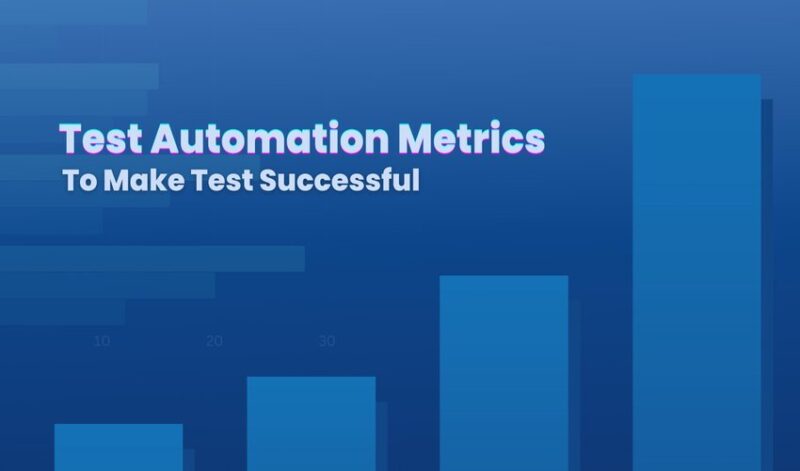Test Automation Metrics to Make Test Successful
By Metrics, we mean KPIs (Key Performance Indicators). As to its name, it is used to measure the performance of a particular process. It works as an indicator. There can be one or two or even more performance indexes in a task or a project, but it is very important to have a minimum of one because if you can measure it, you can’t improve it.
It is not only about choosing the metrics or KPI for the process but choosing the right one. As every process has different aims, requirements, and processes and comes up with its challenges, complexity, resource requirements, and expectations, it becomes crucial to choose the right one according to your project.
Establishing the Metrics
Everyone in their businesses uses KPIs to monitor and measure their project and process. It becomes very essential to identify where things are going and also gives an open site for improvement. It is not only limited to the project but it is also useful to measure the performance of an individual or a team also. For example, if you need to measure the performance of the human resources team, you can consider KPI metrics like the hiring process, Smooth Onboarding, Employee retention rate, COH (cost of hiring), etc.
These same can be applied to test automation also. It helps in identifying the process and the path to the manager. It helps him understand individual performance, team performance, and process performance also, to improve the overall performance of the project and organization.
But it is equally important to choose the right KPIs. They vary according to the projects and the program. Because every project comes with different characteristics, thus it becomes very important for the manager to choose the right one.
However, these metrics fall into several categories, which can be chosen by the manager according to the project requirement. Here is a list of some important metrics to look for:
Types of Test Automation Metrics
● Process Metrics
● Product Metrics
● Project Metrics
● Base Metrics
● Test Pass Rate
● Defect Resolution
● Automated Test Coverage
● Execution Time
#1- Process Metrics
Process metrics include different components, attributes, and execution of the process. The process is a very important part of any project as the quality of the software directly relates to it.
The process metrics break down into small tasks and the time taken by each of them. As the software is not a physical object, it becomes very important to keep track of the small parts. It becomes easy for the manager to keep an eye on each of the tasks, their assigned, the time allotted to the task, and the status of the task which eventually falls into the project progresses.
#2- Product Metrics
A product’s design, quality, efficiency, performance, reliability, security, and many other aspects are defined by these metrics. Product metrics are very important for software development. As automation testing helps by providing guidance and support to the overall development process. These product metrics fall into two categories,
1. Dynamic Metrics
2. Static Metrics
Both metrics help in understanding the program, maintaining the program, and checking the efficiency of the program and reliability of the program. Overall, these product metrics are useful in the improvement of the software and overall testing.
#3- Project Metrics
The project metrics are also useful for the manager to manage the overall project. The main objective of these metrics is to identify how the resources are being used in the process, how they are scheduled, how much would they cost to the project, and how to best utilize them thoughtfully.
#4- Base Metrics
The base metrics are all about collecting data from the different development and execution of test cases. This helps in getting insight into the project status by providing reports to the respective stakeholders. It is measured by the,
1. Total number of cases developed
2. Total number of cases completed
3. Overall time to complete the testing
#5- Test Pass Rate
These metrics also provide insight into the quality of the product and stability of the test suite by portraying the % of test cases passed. The higher the number of test cases % passes, the better the software quality is with fewer bugs. It can be calculated by dividing the total number of passed test cases by the total number of test cases executed.
As the process progresses, Increase in the number defines the QA team’s inability to close the bugs while a decrease in the number means teams have to re-open the bugs.
In both cases, the Respective Manager has to collaborate with the development team and identify the cause to solve it.
#6- Defect Resolution
As simple as it seems, this is the most effective masseur for identifying the effectiveness of the software. When you run the test script and identify the defects in it, it eventually measures the effectiveness of the program you are running. This also effectively measures the team’s effectiveness in solving the problem.
#7- Automated Test Coverage
It is being used when you run other types of testing also along with automation testing. It measures the coverage of the automation testing from the whole testing process. It is measured by the total percentage of the automation test compared to the total test run to identify the % of the automation test coverage.
#8- Execution Time
Execution time is the metric to understand the overall time invested in the process, how much time will be taken by the specific process, and the overall estimation of the project delivery time to figure out the cost of the process.
So, these are some of the significant metrics for test automation. Choose your KPIs wisely and get the best out of the testing process.

Aimee Garcia is a senior editor at ReadDive. She has 5+ years of experience in Digital Marketing. She has worked with different IT companies.





